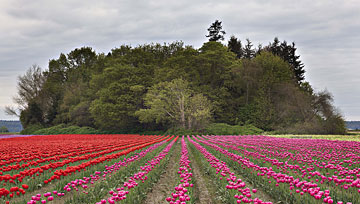Nature’s University offers course in human relations
COFFEE WITH WARREN, with Warren Harbeck
Cochrane Eagle, May 16, 2012

A community of tulips and trees speaks of the harmony of life in Nature’s University, a metaphor of how people of diverse backgrounds can live together in peace. Photo by Jack Blair
How wonderful it is that our trees, lawns and gardens are once more alive with the joys of springtime!
But have you noticed how, in their diversity of growth, they’re also alive with a valuable lesson about people getting along together?
Cochrane photo-essayist Jack Blair reminded me of that lesson recently by way of a photo he’d taken in La Conner, Washington at this year’s Skagit Valley Tulip Festival. (See last week’s column.)
When he took the stunningly symmetrical image, two thoughts went through his mind, he says: the beauty of the vibrant lines of tulips converging into the distance; and the sheltering presence of the integrated growth of strong trees beyond, protecting the fragile flowers from harsh weather.
This symbiosis between the tulips and the trees brought back memories of wisdom he and I both learned back in the 1960s from the late Stoney Nakoda Chief Walking Buffalo in his “course” on human relations at “Nature’s University.” (See my column for Aug. 25, 2010, on how Jack first met Walking Buffalo.)
Consider all the different kinds of trees and plants there are in the forest, the globetrotting goodwill ambassador would say. There are poplars, spruce, pine, willow, cranberry, and a wide variety of flowers. But they don’t fight with each other. They get along together just fine; they live in harmony.
Then he’d ask: Why can’t people do the same?
Jack’s photo and Walking Buffalo’s lesson from Nature’s University recalled for me a similar lesson I learned from former Chiniki First Nation Chief Henry Holloway – a lesson I love repeating often.
It was a beautiful June Saturday morning in 1995, although I remember it like it was yesterday. Nora Schmidt had organized the Cochrane Aboriginal Recognition Event, a weekend celebration among folks from the Cochrane area and Morley, centre of the Stoney Nakoda First Nation.
Many families from up and down our valley were gathered near a tepee erected for the occasion at Cochrane Ranche. As soon as then-mayor Lydia Graham spotted the Chiniki chief, she invited him to come to the outdoor platform to say a few words.
Henry had no prepared speech, nor did he mount the platform with anything other than the down-home-on-the-ranch manner of someone who loved horses, cattle, the open range, and most of all, people.
Looking around at the folks sitting together on the lawn in front of him, he began reminiscing about how the old-timers used to sit together on the bench outside the saddle shop along Cochrane’s main drag.
On that bench at any one time there’d be ranchers from the Jumping Pound area and from north and west of Cochrane. And yes, some were from Morley, too. They’d be comparing ropes and the latest news on livestock auctions, and so forth.
“But they weren’t sitting there as wasijubi – ‘White People’ – at one end of the bench, and as Îyethkabi – ‘Stoneys” – at the other end,” he said. “They were together on that bench just as wîchastabi – just as ‘human beings’ who were enjoying each other for what they shared in common.”
Today, like those ranchers, and like a beautiful garden of diverse plants sharing in common the good earth, fresh air and nourishing sun in Nature’s University, may we, too, here in our part of the Bow Valley so rich in cultural diversity, experience the joy of living together in harmony.
© 2012 Warren Harbeck
JoinMe@coffeewithwarren.com